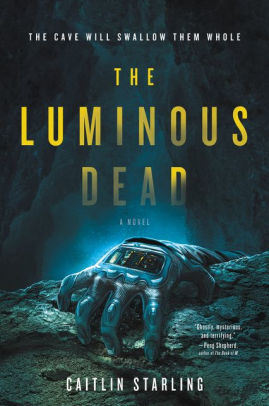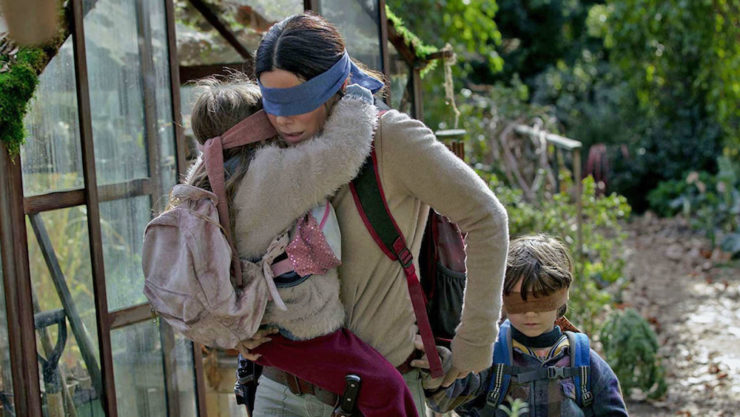This essay is a continuation of “Constructing Blindness,” a series by Hugo Award finalist fanwriter Elsa Sjunneson-Henry.
“I’ve been blind from birth,” is what I usually tell people, even though it’s technically not true. The only world I can remember is the world of being blind, though, so it seems like a truth even if it isn’t precisely what’s true.
“Oh, I’m so sorry.” They reply, their voices sotto and hushed, as though to speak about my disability is scary or harmful. As though what’s obvious from the guide dog at my side (or the white cane in my hand) and the occluded cataract of my right eye is something I am trying to hide.
On the one hand, people are guilty for talking about my, as they might call it, deficiency. They are worried they are drawing attention to a difference which I’m more than happy to talk about—a personality trait which definitely makes people uncomfortable.
By the same token, though, people are fascinated. Many of them have never spoken to a blind person before; they are unaware of what it’s like to live the life that I do.
For most sighted people, the assumption is that there is only one kind of blindness. That no blind person wears glasses, that we cannot read, or use cell phones, that for all of us it is a resignation to the darkness.
Some of this is because of the media that we’re exposed to (see last month’s column on The Chilling Adventures of Sabrina for more on that) and some of it is because, up until the Americans with Disabilities Act was passed in the 1990s, it was a lot easier to shove a disabled relative or independent person into an institution and call it good.
Which is what makes the prospect of sighted authors writing blind people difficult. Because ultimately, if you think that blindness is only one thing, how can you accurately portray a disability with such diversity that it’s almost impossible to categorize what blindness even is?
One of the things presently informing my perspective here is that I attended guide dog school in March of 2019 and I was surrounded by twelve other blind people—all with completely different varieties of blindness from my own. I was the only one with congenital cataracts, for example.
This is why I really like it when sighted authors don’t actually write blind people when they employ lack of sight as a storytelling device, and instead turn to other methods for exploring what it’s like to live in the dark.
It is unusual for a sighted author to get the world of the blind right. Most sighted people make giant leaping assumptions about what it is like to be blind—glossing over the realities of safety, security, and independence in favor of isolation and grief. Which is why I’ve found Bird Box—the 2014 novel that was adapted into the recent Netflix film—to be an interesting and notable exception to the rule. Author Josh Malerman didn’t take the usual route of trying to imagine what it was like to be blind. He didn’t try and interpret an experience he doesn’t understand.
Instead, Malerman took a bunch of normal sighted people and shoved them into the dark as a way to survive in an apocalypse designed to kill anyone with working eyes. The reason I liked this is that it reads true—the novel reads convincingly like a bunch of sighted people bumbling around in the dark and having to find their way.
I should note, though, that one of the questions that I had about Bird Box is inextricably tied in with the reason it works: why are blind people relegated to the last chapter? They are presented as an afterthought in an apocalypse which, while designed to target and destroy the sighted, is uniquely designed to make the world the kingdom of the blind. And this is replicated in the film adaptation, as well.
While the book seemed to distinctly understand the vast difference between the sighted protagonist’s experience and that of a blind person navigating a world with which they are familiar, however, the film didn’t seem to. Between shots of shaky cam behind blindfolds, watching able-bodied people trying to manufacture adaptive tools and reinvent the wheel became almost painful. More than once I shouted at the screen, “But that’s what a white cane is for!” It was frustrating to me because I feel like at least one person would have seen a blind person crossing a street with a white cane before. It’s especially frustrating because in many ways, after years of living with blindfolds, people were still behaving like the sighted.
In the end, where the novel by Josh Malerman made me feel as though a sighted author understood that the sighted experience of not being able to see and the blind experience are distinct skill sets, the film version did no such thing. The film depicts the home of the blind as a beautiful haven, but what it did not do was show the range and diversity of blindness, or portray the use of adaptive devices widely. I did not get to watch a real blind person work a cane for more than a second, I did not get to watch a guide dog zip through a crowd. Yes, it was wonderful to see blind people thriving at the end of the film, but in some ways I would have preferred to hear their story, to get some sense of their experience and the ways in which it differed from the protagonists’.
Buy the Book


The Luminous Dead
Malerman is not the only author to play with sight as a means of developing horror and suspense—in fact it is a relatively well-known trope. Films like Don’t Breathe and Wait Until Dark have used it as a method for inspiring fear in their audience, but these narratives are constructed using blindness as the problem. In Wait Until Dark, for example, a recently blinded woman is trapped in her own home with a group of thieves. The expected terror and unease is generated because the presumably sighted audience cannot imagine being in her situation, or relate to her experience. For me, the horror is because as a blind woman, that film portrays me as an easy victim. (For the record, I found Wait Until Dark so viscerally upsetting I never finished it.)
In Caitlin Starling’s debut The Luminous Dead she plays with sight in a very different way. Rather than taking her characters’ sight away through fear of an outside threat (as in Bird Box), it’s a matter of the setting: a deep cave on a sci-fi planet. Her protagonist, Gyre, navigates a cave using various technologies to enhance her sight underground, but the primary method of travel is through feel, and the knowledge of her environment comes through maps and a handler who’s responsible for guiding her along the way.
In many ways, Starling, perhaps unknowingly, has depicted a large part of the blind experience—having to trust those people in your environment who can see where you are to guide you, and having to rely on your wits and your knowledge of the space you are in to make your way through an environment. It’s amazing what a little challenge in worldbuilding can accomplish.
Both Bird Box and The Luminous Dead show readers a world where lack of sight builds interest and tension, but without the misapprehensions and the heavy layer of ableist guilt that characterize many books that seek to specifically address blindness as a condition or situation. It’s my hope that abled authors will look at these examples, and begin to divorce their constructions of blindness from their own misplaced sense of guilt and ableist assumptions: Rather than assuming that a blind person is helpless within the world of the sighted, consider what we can do in the dark.
In the end, only by divorcing the narrative from the constructions of blindness that we see in shows like The Chilling Adventures of Sabrina, the CW’s new series In The Dark (oh, don’t you worry, reader—I’ll be covering this in a future column!), and in many other films and books, will we get a more realistic portrayal of what it’s like to live without sight.
Elsa Sjunneson-Henry is a gimlet made from feminism and snark. She’s a deafblind speculative fiction author, and she writes disability focused nonfiction as well. Her work has appeared in Uncanny, Fireside, Tor.com, CNN, and The Boston Globe, and she is a 2019 Hugo Award finalist for Best Fan Writer, as well as a Best Semiprozine Hugo finalist for her work as an editor on Fireside Magazine and Uncanny Magazine’s Disabled People Destroy Science Fiction Special Issue. She writes from a dragon lair in NJ, and can be found on the web @snarkbat and snarkbat.com











I might have missed the column, but do you have any commentary on Jose Saramago’s Blindness? (Or, will you in the future? I can wait!) I (a sighted person) loved it while also feeling simultaneously very uncomfortable with reactions-to-blindness as metaphor for, uh, fascism? I think? But it’s also not “blindness is a nightmare” but “how we treat each other in adversity is a nightmare”.